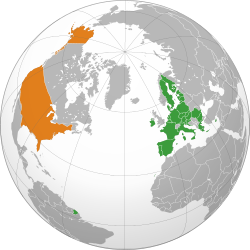Relations between the European Union and the United States

|
|
|
|
|
| EU | United States |
The relations between the European Union (EU) and the United States of America (USA) play mainly in the economic and political from the field. Both power blocs often have a similar opinion in international conflicts, which is partly due to historical circumstances and partly due to the fact that both the USA and most of the EU member states are in NATO . The cooperation is also known as transatlantic relations.
history
The vast majority of the white US population is descended from immigrants from what is now the EU. Since the 17th century, there has been increased migration from Europe to the US.
Diplomatic relations have existed between the USA and the ECSC , the forerunner of the EU, since 1953 . A year later, the EU Commission opened its first diplomatic representation in Washington , and the US State Department followed in 1961 with a representation in Brussels . The EU representation in Washington applies not only to stronger cooperation with the US government, but also with other international organizations based in the US capital, such as the International Monetary Fund. Three years later the Commission sent another representative to New York to exercise its observer status at the United Nations .
In November 1990 a transatlantic declaration was signed between the two partners, and since then the presidents of the EU Commission and the USA have maintained relations with each other at regular summits. A big step towards closer political cooperation was taken in 1995 at the European-American summit in Madrid , at which the then EU Commission President Jacques Santer and US President Bill Clinton signed the New Transatlantic Agenda (NTA). The main items on the agenda are:
- Promoting peace and stability, democracy and development
- Overcoming global challenges
- Promote the expansion of world trade and establish closer economic ties
At the 1998 summit in London, it was decided to establish the Transatlantic Economic Partnership. This partnership led the EU and the USA to conclude several agreements in the following years, which deal with the dismantling of tariffs and the removal of trade barriers.
In 2002, an agreement in the area of aviation security was signed, it is intended to align the regulations of the two partners and the EU regulation establishing common regulations for civil aviation is taken into account here. The then EU Transport Commissioner Jacques Barrot said that an additional 17 million passengers per year can be expected through this agreement and that savings of € 5 billion for consumers will be possible due to the reduction in bureaucracy. A similar treaty was signed on ship equipment regulations.
At the 2003 EU-USA summit in Washington, the creation of the Open Aviation Area was decided. A year later in Dublin it was decided to coordinate the two satellite systems Galileo (EU) and GPS (USA) together and to use combined signals.
In 2013, talks on a transatlantic free trade agreement (TTIP) began by EU Commission President José Manuel Barroso , US President Barack Obama and EU Trade Commissioner Karel de Gucht .
Economic relations
The European Union and the USA have traditionally been closely intertwined economically. The background is u. a. the Marshall Plan , with which the USA participated in the economic reconstruction of European states after the Second World War .
In 2011, according to the Federal Foreign Office, a little over 4 percent of global trade in goods was accounted for by trade between the EU and the USA, while trade in services accounted for a good 11 percent. In 2012, goods worth almost 500 billion euros were traded. The EU exported goods worth 291.9 billion euros and imported goods worth 205.8 billion euros from the United States. Excluding trade between the EU states, the two economic blocs form each of the largest trading partners with each other.
Due to numerous agreements, the average tariff on industrial goods is 3 percent.
Web links
Individual evidence
- ↑ The European Union and the United States - Global Partners, Global Responsibility
- ↑ Federal Foreign Office as of August 28, 2014
- ^ Konrad Adenauer Foundation
- ↑ EU - USA - China: Trade Relations (PDF) , bpb data from 2010
